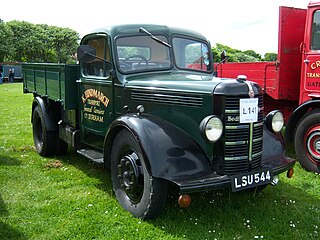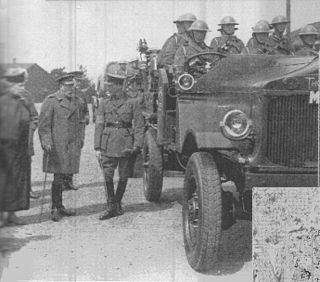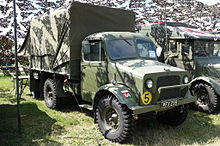
Commer was a British manufacturer of commercial and military vehicles from 1905 until 1979. Commer vehicles included car-derived vans, light vans, medium to heavy commercial trucks, and buses. The company also designed and built some of its own diesel engines for its heavy commercial vehicles.

The Studebaker US6 (G630) was a series of 2+1⁄2-ton 6×6 and 5-ton 6×4 trucks manufactured by the Studebaker Corporation and REO Motor Car Company during World War II. The basic cargo version was designed to transport a 2+1⁄2-short-ton cargo load over any type of terrain in any weather. Most of these were exported to the Soviet Union under Lend-Lease by the USA during World War II, since the competing GMC 6×6 CCKW design proved to be more suitable for Western Front conditions.
Scammell Lorries Limited was a British manufacturer of trucks, particularly specialist and military off-highway vehicles, between 1921 and 1988. From 1955 Scammell was part of Leyland Motors.

The AEC Matador was a heavy 4×4 truck and medium artillery tractor built by the Associated Equipment Company for British and Commonwealth forces during World War II. AEC had already built a 4×2 lorry, also known as the Matador.
Bedford Vehicles, usually shortened to just Bedford, was a brand of vehicle manufactured by Vauxhall Motors, then a subsidiary of multinational corporation General Motors. Established in April 1931, Bedford Vehicles was set up to build commercial vehicles. The company was a leading international lorry brand, with substantial export sales of light, medium, and heavy lorries throughout the world.

The Bedford OXA was a British heavy improvised armoured car, produced during the Second World War.

The Bedford M series is a line of commercial vehicle chassis, the first variants of which were made in 1939 by Bedford. It is a normal control 4-wheel chassis designed to carry loads of 2-3 tons. There were two wheelbase lengths offered – 10' 0" or 11' 11" – and each was fitted with the standard 6-cylinder 76 bhp petrol engine. A 4-speed gearbox with single dry plate clutch delivered power to a floating rear axle with spiral bevel final drive. Brakes were Lockheed hydraulic type and vacuum assisted operating on all four wheels.

The Scammell Pioneer was a British 6×4 tractor unit used in World War II as an artillery tractor, recovery vehicle and tank transporter.

The Bedford CA was a distinctive pug-nosed light commercial vehicle produced between 1952 and 1969 by Bedford in Luton, England.

The Bedford RL was the British military's main medium lorry, built by Bedford from the mid-1950s until the late 1960s. The lorry was based on the civilian Bedford S type, first introduced in 1950. They superseded the Bedford QL, and were in turn superseded by the Bedford MK/MJ.

Canadian Military Pattern (CMP) trucks were mutually coherent ranges of military trucks, made in large numbers, in several classes and numerous versions, by Canada's branches of the U.S. 'Big Three' auto-makers during World War II, compliant to British Army specifications, primarily intended for use in the armies of the British Commonwealth allies, but also serving in other units of the British Empire.

The Thornycroft Hathi was an early four wheel drive lorry built by Thornycroft in the 1920s. It was used by the British Army as an artillery tractor.

The concept of the Mechanical Horse tractor unit with an easily detached articulated trailer was conceived in the early 1930s by Napier & Son. It has one front wheel in the midline. The London and North Eastern Railway had approached Napier for an answer to the problem of replacing horses for local haulage purposes, while retaining the flexibility of changing the wagons and the maneuverability of the horse and wagon. These vehicles are often known as "Snub-nose Trucks" or "Snub-nose Lorries" because of the round hood in front of the cab.

The Mack model EH trucks were a family of 4x2 trucks used by the US and British military before and during World War II. They were built in conventional and cab-over-engine models and were used as both trucks and semi-tractors. Originally a commercial design, in 1943 a military version became standard.

Victor Electrics Ltd was a British manufacturer of milk floats and other battery electric road vehicles. The company was formed in 1923 by Outram's Bakery in Southport, Merseyside, to make bread vans for their own use, but they soon diversified into other markets, including the Dairy industry. Their first vehicles had bonnets, like conventional vans, which stored the batteries, but by 1935 all of their vehicles were forward control models, with the cab at the front. They were acquired by Brook Motors in 1967, and became part of the Hawker Siddeley group in 1970. They made a small number of railway locomotives during this latter period.

The Bedford S is a heavy lorry produced in Great Britain between 1950 and 1959.

The Bedford MW was a general service truck used by the British Armed Forces during the Second World War.
Walker Brothers Limited was a manufacturer based in Pagefield Ironworks, Wigan, England. It produced ventilation equipment for mining, truck and bus chassis, mobile cranes, and railway locomotives and railcars.

The Leyland Landtrain was a truck that was produced in the 1980s by British Leyland. Designed for the export markets in Africa, Asia, Latin America and the Middle East, it was particularly popular in Nigeria, Kenya and Zimbabwe. The Landtrain was designed to be used in areas of limited infrastructure, where roads may be rough and fuel scarce. It was powered by four different engines and produced with three different gross vehicle weights (GVW), 19 tonnes, 30 t and 36 t

The Morris Commercial CS8, also known as the "Morris 15 cwt" was a British light military truck of the Second World War.





















